fuel pressure lexus LC500 2020 Owner's Manual / LEXUS 2020 LC500,LC500H OWNER'S MANUAL (OM11537U)
[x] Cancel search | Manufacturer: LEXUS, Model Year: 2020, Model line: LC500, Model: Lexus LC500 2020Pages: 436, PDF Size: 13.86 MB
Page 1 of 436
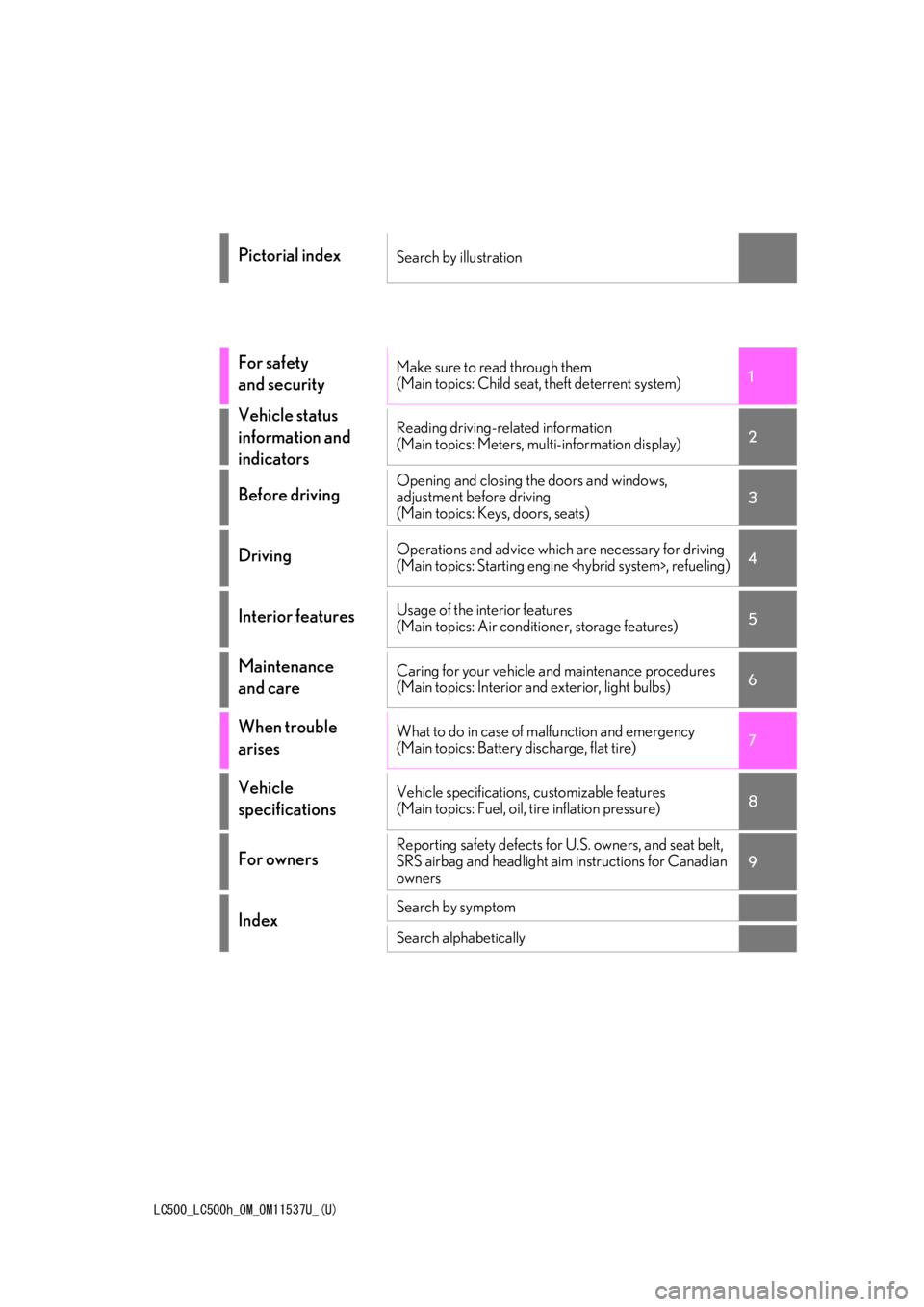
LC500_LC500h_OM_OM11537U_(U)
1
2
3
4
5
6
7
8
9
Pictorial indexSearch by illustration
For safety
and securityMake sure to read through them
(Main topics: Child seat, theft deterrent system)
Vehicle status
information and
indicatorsReading driving-related information
(Main topics: Meters, multi-information display)
Before drivingOpening and closing the doors and windows,
adjustment before driving
(Main topics: Keys, doors, seats)
DrivingOperations and advice which are necessary for driving
(Main topics: Starting engine
Interior featuresUsage of the interior features
(Main topics: Air conditioner, storage features)
Maintenance
and careCaring for your vehicle and maintenance procedures
(Main topics: Interior and exterior, light bulbs)
When trouble
arisesWhat to do in case of malfunction and emergency
(Main topics: Battery discharge, flat tire)
Vehicle
specificationsVehicle specifications, customizable features
(Main topics: Fuel, oil, tire inflation pressure)
For ownersReporting safety defects for U.S. owners, and seat belt,
SRS airbag and headlight aim instructions for Canadian
owners
IndexSearch by symptom
Search alphabetically
Page 4 of 436
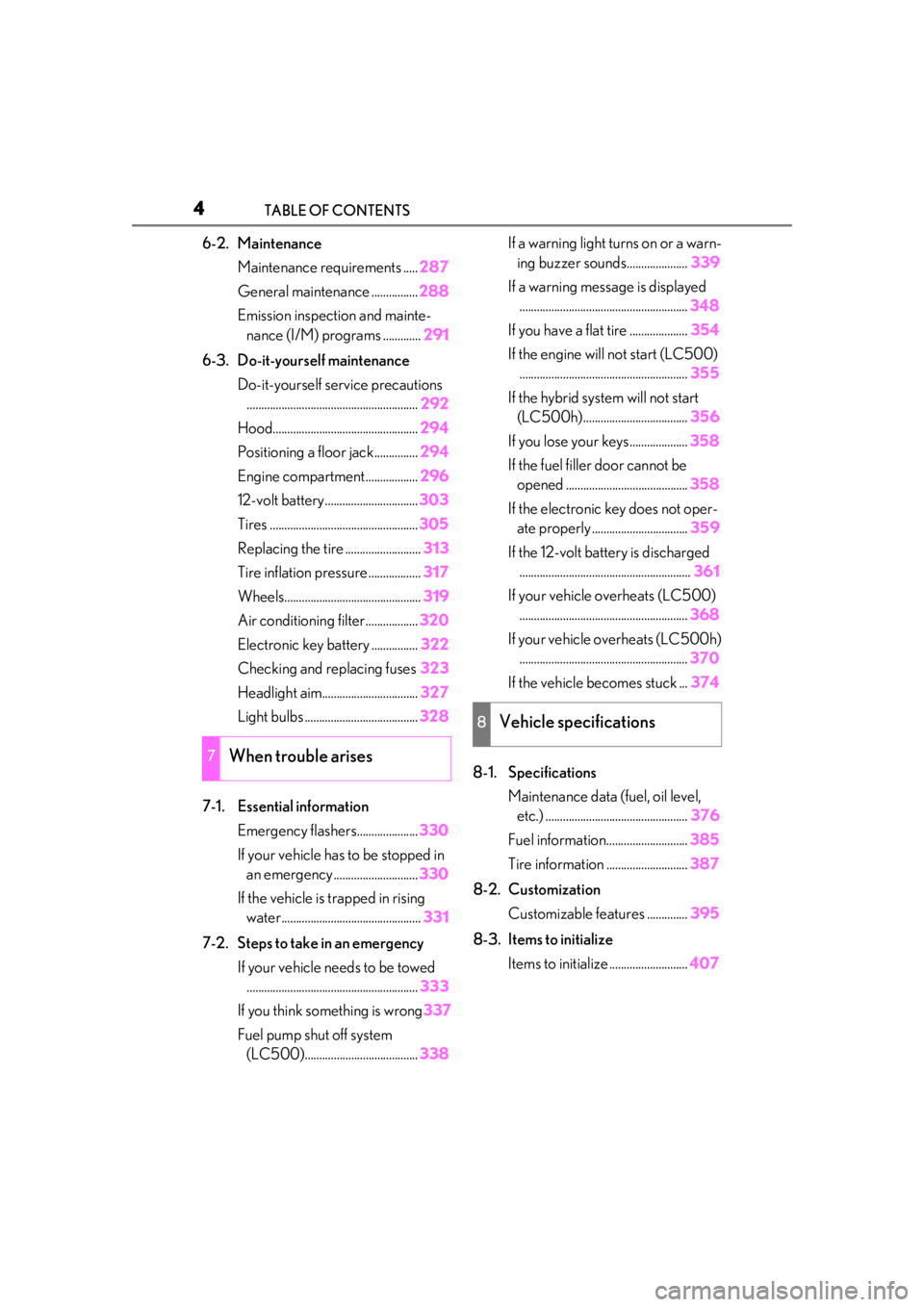
4TABLE OF CONTENTS
6-2. MaintenanceMaintenance requirements ..... 287
General maintenance ................ 288
Emission inspection and mainte- nance (I/M) programs ............. 291
6-3. Do-it-yourself maintenance Do-it-yourself service precautions........................................................... 292
Hood.................................................. 294
Positioning a floor jack............... 294
Engine compartment.................. 296
12-volt battery................................ 303
Tires ................................................... 305
Replacing the tire .......................... 313
Tire inflation pressure .................. 317
Wheels............................................... 319
Air conditioning filter..................320
Electronic key battery ................ 322
Checking and replacing fuses 323
Headlight aim................................. 327
Light bulbs ....................................... 328
7-1. Essential information Emergency flashers..................... 330
If your vehicle has to be stopped in an emergency ............................. 330
If the vehicle is trapped in rising water................................................ 331
7-2. Steps to take in an emergency If your vehicle needs to be towed........................................................... 333
If you think something is wrong 337
Fuel pump shut off system (LC500)....................................... 338If a warning light turns on or a warn-
ing buzzer sounds..................... 339
If a warning messa ge is displayed
.......................................................... 348
If you have a flat tire .................... 354
If the engine will not start (LC500) .......................................................... 355
If the hybrid syst em will not start
(LC500h).................................... 356
If you lose your keys.................... 358
If the fuel filler door cannot be opened .......................................... 358
If the electronic key does not oper- ate properly ................................. 359
If the 12-volt battery is discharged ........................................................... 361
If your vehicle overheats (LC500) .......................................................... 368
If your vehicle overheats (LC500h) .......................................................... 370
If the vehicle becomes stuck ... 374
8-1. Specifications Maintenance data (fuel, oil level, etc.) ................................................. 376
Fuel information............................ 385
Tire information ............................ 387
8-2. Customization Customizable features .............. 395
8-3. Ite
ms to initialize
Items to initialize ........................... 407
7When trouble arises
8Vehicle specifications
Page 13 of 436
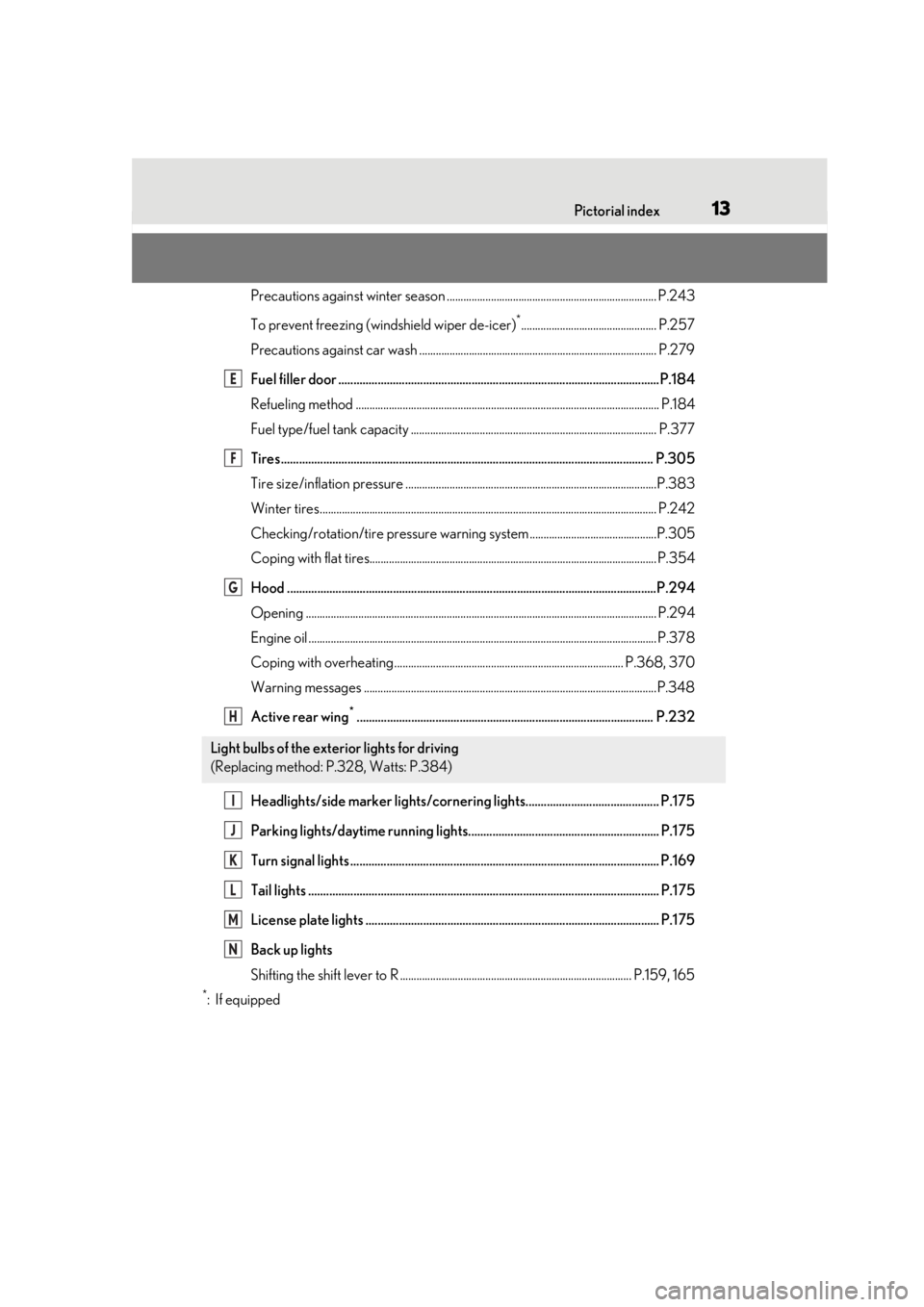
13Pictorial index
Precautions against winter season ............................................................................ P.243
To prevent freezing (windshield wiper de-icer)
*................................................. P.257
Precautions against car wash ...................................................................................... P.279
Fuel filler door ..........................................................................................................P.184
Refueling method .............................................................................................................. P .184
Fuel type/fuel tank capacity ...... ................................................................................... P.377
Tires.......................................................................................................................... .P.305
Tire size/inflation pressure ............................ ...............................................................P.383
Winter tires.......................................................................................................................... P.242
Checking/rotation/tire pressure warning system..............................................P.305
Coping with flat tires........................................................................................................ P .354
Hood ..........................................................................................................................P.294
Opening ............................................................................................................................... P.294
Engine oil ..................................................................................................................... ......... P.378
Coping with overheating ................................................................................... P.368, 370
Warning messages ..........................................................................................................P.348
Active rear wing
*.................................................................................................. P.232
Headlights/side marker lights/cornering lights............................................ P.175
Parking lights/daytime running lights............................................................... P.175
Turn signal lights ...................................................................................................... P.169
Tail lights .................................................................................................................... P.175
License plate lights ................................................................................................. P.175
Back up lights
Shifting the shift lever to R .................................................................................... P.159, 165
*:If equipped
Light bulbs of the exterior lights for driving
(Replacing method: P.328, Watts: P.384)
E
F
G
H
I
J
K
L
M
N
Page 75 of 436

752-1. Instrument cluster
2
Vehicle status information and indicators
Warning lights inform the driver of mal-
functions in the indicated vehicle sys-
tems.
*1: These lights turn on when the engine switch
IGNITION ON mode
indicate that a system check is being
performed. They will turn off after the
engine
Warning lights
(U.S.A.)
Brake system warning light*1
( P.339)
(red)
(Canada)
Brake system warning light*1
( P.339)
Charging system warning
light
*2 ( P.339)
Low engine oil pressure
warning light
*2 ( P.339)
(U.S.A.)
Malfunction indicator lamp*1
( P.340)
(Canada)
Malfunction indicator lamp*1
( P.340)
SRS warning light
*1
( P.340)
(U.S.A.)
ABS warning light*1
( P.340)
(Canada)
ABS warning light*1
( P.340)
(red)
Electric power steering sys-
tem warning light
*1 ( P.340)
(yellow)
Electric power steering sys-
tem warning light
*1 ( P.340)
PCS warning light
*1, 3
( P.341)
(orange)
LKA indicator*2 ( P.341)
Slip indicator*1 ( P.341)
Brake Override System
warning light
( P.342)/Drive-Start Con-
trol warning light
*2 ( P.342)
Brake hold operated indica-
tor
*1, 3 ( P.342)
(U.S.A.)
Parking brake indicator*3
( P.342)
(Canada)
Parking brake indicator*3
( P.342)
(yellow)
Brake system warning light*1
( P.343)
Low fuel level warning light
( P.343)
Driver’s and front passen-
ger’s seat belt reminder light
( P.343)
Rear passengers’ seat belt
reminder lights
*4 ( P.344)
Master warning light
*1
( P.344)
Tire pressure warning light
*1, 3
( P.344)
High coolant temperature
warning light
*2 ( P.344)
(if equipped)
Hybrid system overheat
warning light
*2( P.345)
Page 86 of 436

862-1. Instrument cluster
hands-free system, refer to “NAVI-
GATION SYSTEM OWNER’S
MANUAL”.
■Content of drive information
Select to display various drive data.
Up to 2 of the following items can be
selected.
Items displayed can be switched by
pressing or of the meter con-
trol switches to select and pressing or .
Current fuel consumption
*1
Displays the current rate of fuel consump-
tion
Average fuel economy (after
reset
*2/after start/after refuel)*1
Displays the average fuel consumption
since the function was reset, the engine
cle was refueled, respectively
Use the displayed average fuel consump-
tion as a reference.
Average speed (after reset*2/after
start)
*1
Displays the average vehicle speed since
the function was reset and the engine
Elapsed time (after reset*2/after
start)
*1
Displays the elapsed time since the func-
tion was reset and th e engine
Distance (range/after start)*1
Displays the estimated maximum distance
that can be driven with the quantity of fuel
remaining and the distan ce driven after the
engine
respectively.
• This distance is computed based on your average fuel consumption. As a result,
the actual distance that can be driven
may differ from that displayed.
• When only a small amount of fuel is added to the tank, the display may not be
updated.
When refueling, turn the engine switch
eled without turning the engine switch
be updated.
*1: Displayed when the it em is set in “Drive
Info 1” and “Drive Info 2”.
*2: The function can be reset by pressing “OK” of the meter control switches for
longer than 1 second when the item to
reset is displayed.
If there is more than one item that can
be reset, the item selection screen will
appear.
■Eco Driving Indicator/engine oil
temperature gauge (LC500)
P.78, 80
■Hybrid System Indicator/motor
power display (LC500h)
P.78
■Energy monitor (LC500h)
P.96
■Tire pressure
P.307
■Gear positions
Displays the current shift range or gear
position when the shift position is in D
Drive information
Page 184 of 436
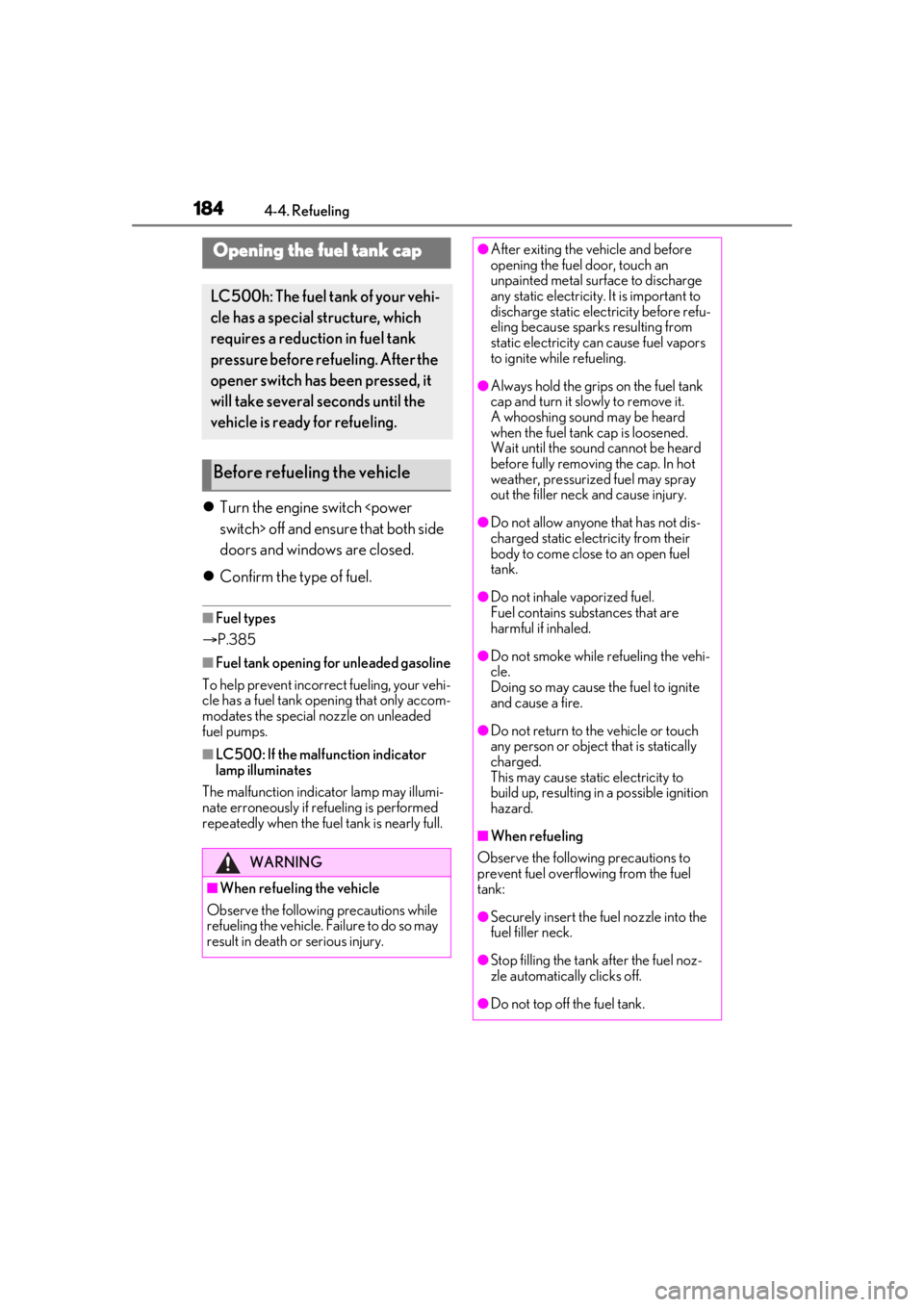
1844-4. Refueling
4-4.Refueling
Turn the engine switch
doors and windows are closed.
Confirm the type of fuel.
■Fuel types
P.385
■Fuel tank opening for unleaded gasoline
To help prevent incorrect fueling, your vehi-
cle has a fuel tank opening that only accom-
modates the special nozzle on unleaded
fuel pumps.
■LC500: If the malf unction indicator
lamp illuminates
The malfunction indicator lamp may illumi-
nate erroneously if refueling is performed
repeatedly when the fuel tank is nearly full.
Opening the fuel tank cap
LC500h: The fuel ta nk of your vehi-
cle has a special structure, which
requires a reduction in fuel tank
pressure before refueling. After the
opener switch has been pressed, it
will take several seconds until the
vehicle is ready for refueling.
Before refueling the vehicle
WARNING
■When refueling the vehicle
Observe the following precautions while
refueling the vehicle. Failure to do so may
result in death or serious injury.
●After exiting the vehicle and before
opening the fuel door, touch an
unpainted metal surf ace to discharge
any static electricity. It is important to
discharge static elec tricity before refu-
eling because sparks resulting from
static electricity can cause fuel vapors
to ignite while refueling.
●Always hold the grips on the fuel tank
cap and turn it slowly to remove it.
A whooshing sound may be heard
when the fuel tank cap is loosened.
Wait until the sound cannot be heard
before fully removing the cap. In hot
weather, pressurized fuel may spray
out the filler neck and cause injury.
●Do not allow anyone that has not dis-
charged static electricity from their
body to come close to an open fuel
tank.
●Do not inhale vaporized fuel.
Fuel contains substances that are
harmful if inhaled.
●Do not smoke while refueling the vehi-
cle.
Doing so may cause the fuel to ignite
and cause a fire.
●Do not return to the vehicle or touch
any person or object that is statically
charged.
This may cause static electricity to
build up, resulting in a possible ignition
hazard.
■When refueling
Observe the following precautions to
prevent fuel overflowing from the fuel
tank:
●Securely insert the fuel nozzle into the
fuel filler neck.
●Stop filling the tank after the fuel noz-
zle automatically clicks off.
●Do not top off the fuel tank.
Page 241 of 436
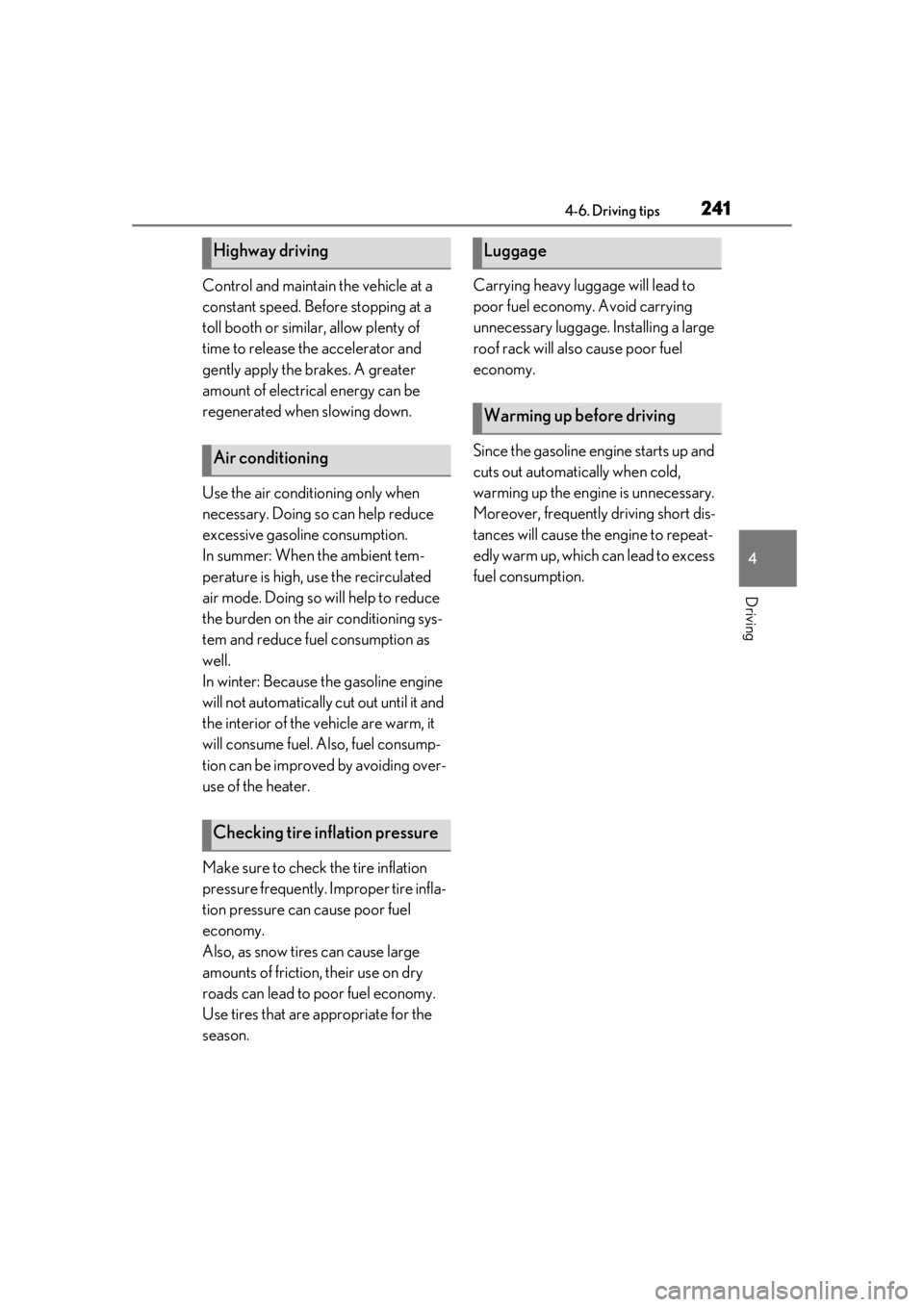
2414-6. Driving tips
4
Driving
Control and maintain the vehicle at a
constant speed. Before stopping at a
toll booth or similar, allow plenty of
time to release the accelerator and
gently apply the brakes. A greater
amount of electrical energy can be
regenerated when slowing down.
Use the air conditioning only when
necessary. Doing so can help reduce
excessive gasoline consumption.
In summer: When the ambient tem-
perature is high, use the recirculated
air mode. Doing so will help to reduce
the burden on the air conditioning sys-
tem and reduce fuel consumption as
well.
In winter: Because the gasoline engine
will not automatically cut out until it and
the interior of the vehicle are warm, it
will consume fuel. Also, fuel consump-
tion can be improved by avoiding over-
use of the heater.
Make sure to check the tire inflation
pressure frequently. Improper tire infla-
tion pressure can cause poor fuel
economy.
Also, as snow tires can cause large
amounts of friction, their use on dry
roads can lead to poor fuel economy.
Use tires that are appropriate for the
season. Carrying heavy luggage will lead to
poor fuel economy. Avoid carrying
unnecessary luggage.
Installing a large
roof rack will also cause poor fuel
economy.
Since the gasoline engine starts up and
cuts out automatically when cold,
warming up the engine is unnecessary.
Moreover, frequently driving short dis-
tances will cause the engine to repeat-
edly warm up, which can lead to excess
fuel consumption.
Highway driving
Air conditioning
Checking tire inflation pressure
Luggage
Warming up before driving
Page 293 of 436
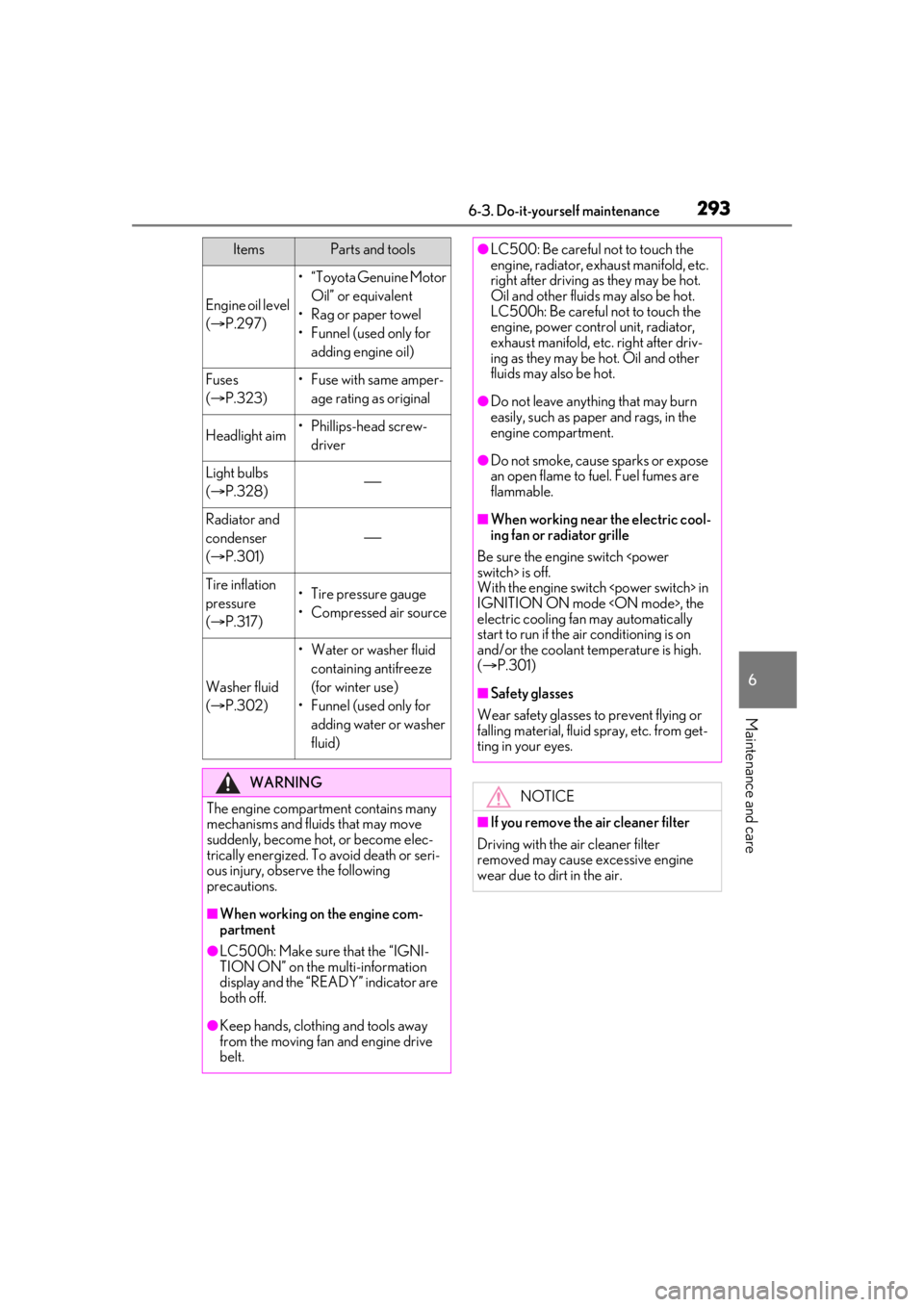
2936-3. Do-it-yourself maintenance
6
Maintenance and care
Engine oil level
( P.297)
• “Toyota Genuine Motor
Oil” or equivalent
• Rag or paper towel
• Funnel (used only for adding engine oil)
Fuses
( P.323)•Fuse with same amper-
age rating as original
Headlight aim• Phillips-head screw-driver
Light bulbs
( P.328)
Radiator and
condenser
( P.301)
Tire inflation
pressure
( P.317)• Tire pressure gauge
• Compressed air source
Washer fluid
( P.302)
• Water or washer fluid
containing antifreeze
(for winter use)
• Funnel (used only for adding water or washer
fluid)
WARNING
The engine compartment contains many
mechanisms and fluids that may move
suddenly, become hot, or become elec-
trically energized. To avoid death or seri-
ous injury, observe the following
precautions.
■When working on the engine com-
partment
●LC500h: Make sure that the “IGNI-
TION ON” on the multi-information
display and the “READY” indicator are
both off.
●Keep hands, clothi ng and tools away
from the moving fan and engine drive
belt.
ItemsParts and tools●LC500: Be careful not to touch the
engine, radiator, exhaust manifold, etc.
right after driving as they may be hot.
Oil and other fluids may also be hot.
LC500h: Be careful not to touch the
engine, power control unit, radiator,
exhaust manifold, etc. right after driv-
ing as they may be hot. Oil and other
fluids may also be hot.
●Do not leave anything that may burn
easily, such as paper and rags, in the
engine compartment.
●Do not smoke, cause sparks or expose
an open flame to fuel. Fuel fumes are
flammable.
■When working near the electric cool-
ing fan or radiator grille
Be sure the engine switch
With the engine switch
IGNITION ON mode
electric cooling fan may automatically
start to run if the air conditioning is on
and/or the coolant temperature is high.
( P.301)
■Safety glasses
Wear safety glasses to prevent flying or
falling material, fluid spray, etc. from get-
ting in your eyes.
NOTICE
■If you remove the air cleaner filter
Driving with the air cleaner filter
removed may cause excessive engine
wear due to dirt in the air.
Page 318 of 436

3186-3. Do-it-yourself maintenance
Tire pressure gauge
1 Remove the tire valve cap.
2 Press the tip of the tire pressure
gauge onto the tire valve.
3 Read the pressure using the gauge
gradations.
4 If the tire inflation pressure is not at
the recommended level, adjust the
pressure.
If you add too much air, press the
center of the valve to deflate.
5 After completing the tire inflation
pressure measurem ent and adjust-
ment, apply soapy water to the
valve and check for leakage.
6 Put the tire valve cap back on.
■Tire inflation pressure check interval
You should check tire inflation pressure
every two weeks, or at least once a month.
Do not forget to check the spare.
■Effects of incorrect tire inflation pres-
sure
Driving with incorrect ti re inflation pressure
may result in the following:
●Reduced fuel economy
●Reduced driving comfort and poor han-
dling
●Reduced tire life due to wear
●Reduced safety
●Damage to the drivetrain
If a tire needs frequent inflating, have it
checked by your Lexus dealer.
■Instructions for checking tire inflation
pressure
When checking tire inflation pressure,
observe the following:
●Check only when the tires are cold.
If your vehicle has been parked for at
least 3 hours or has not been driven for more than 1 mile or 1.5 km, you will get an
accurate cold tire inflation pressure read-
ing.
●Always use a tire pressure gauge.
It is difficult to judge if a tire is properly
inflated based only on its appearance.
●It is normal for the ti
re inflation pressure
to be higher after driving as heat is gen-
erated in the tire. Do not reduce tire infla-
tion pressure after driving.
●Never exceed the vehicle capacity
weight.
Passengers and luggage weight should
be placed so that the vehicle is balanced.
B
WARNING
■Proper inflation is critical to save tire
performance
Keep your tires properly inflated.
If the tires are not properly inflated, the
following conditions may occur which
could lead to an accident resulting in
death or serious injury:
●Excessive wear
●Uneven wear
●Poor handling
●Possibility of blowouts resulting from
overheated tires
●Air leaking from between tire and
wheel
●Wheel deformation and/or tire dam-
age
●Greater possibility of tire damage
while driving (due to road hazards,
expansion joints, sharp edges in the
road, etc.)
Page 345 of 436
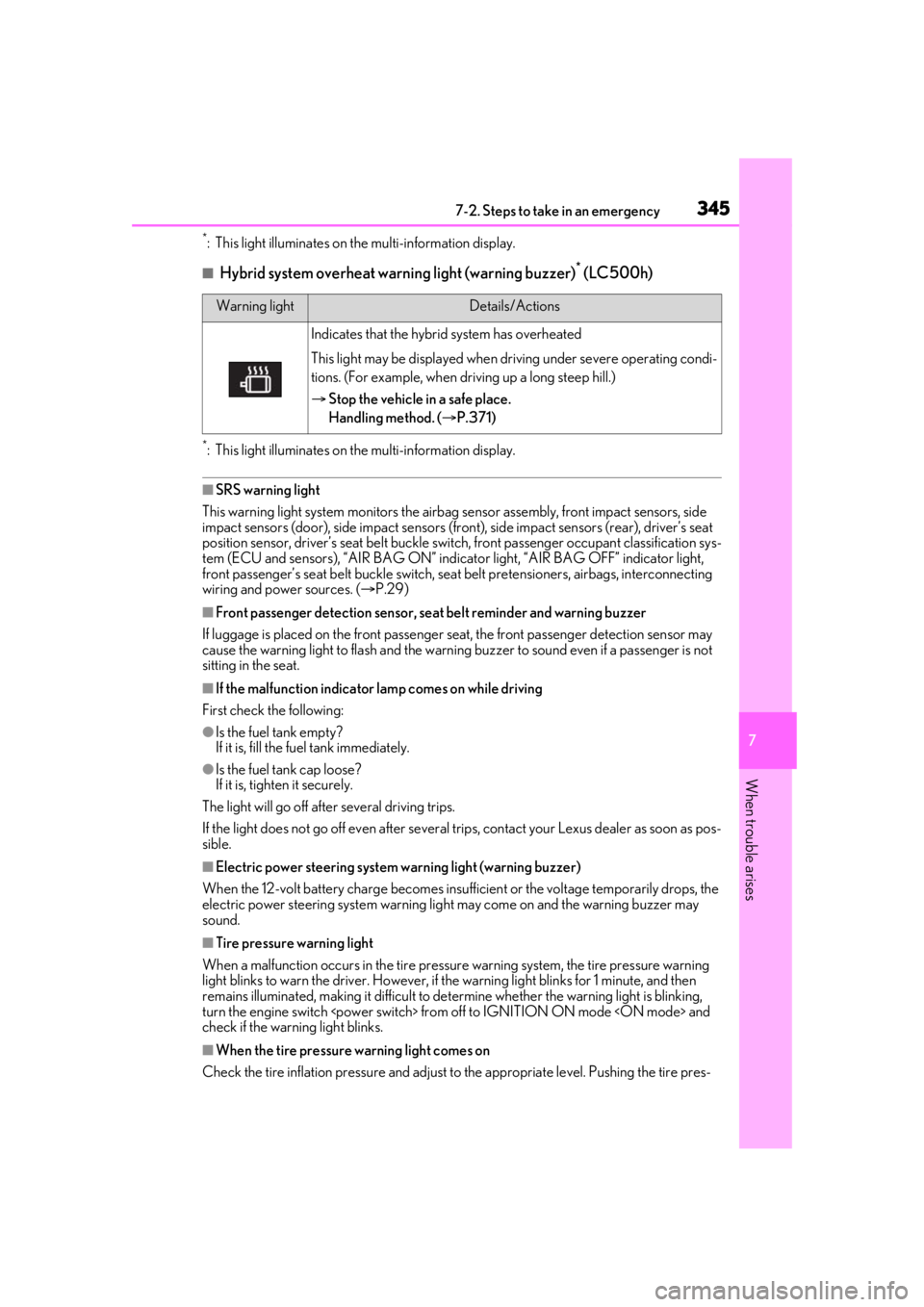
3457-2. Steps to take in an emergency
7
When trouble arises
*: This light illuminates on the multi-information display.
■Hybrid system overheat warning light (warning buzzer)* (LC500h)
*: This light illuminates on the multi-information display.
■SRS warning light
This warning light system monitors the airbag sensor assembly, front impact sensors, side
impact sensors (door), side impa ct sensors (front), side impact sensors (rear), driver’s seat
position sensor, driver’s seat belt buckle switch, front passeng er occupant classification sys-
tem (ECU and sensors), “AIR BAG ON” indicat or light, “AIR BAG OFF” indicator light,
front passenger’s seat be lt buckle switch, seat belt preten sioners, airbags, interconnecting
wiring and power sources. ( P.29)
■Front passenger detection sensor, seat belt reminder and warning buzzer
If luggage is placed on the front passenger seat, the front passenger detection sensor may
cause the warning light to flash and the warning buzzer to sound even if a passenger is not
sitting in the seat.
■If the malfunction indicator lamp comes on while driving
First check the following:
●Is the fuel tank empty?
If it is, fill the fuel tank immediately.
●Is the fuel tank cap loose?
If it is, tighten it securely.
The light will go off af ter several driving trips.
If the light does not go off even after several trips, contact your Lexus dealer as soon as pos-
sible.
■Electric power steering system warning light (warning buzzer)
When the 12-volt battery charge becomes insufficient or the voltage temporarily drops, the
electric power steering syst em warning light may come on and the warning buzzer may
sound.
■Tire pressure warning light
When a malfunction occurs in the tire pressure warning system, the tire pressure warning
light blinks to warn the driver . However, if the warning light blinks for 1 minute, and then
remains illuminated, making it difficult to determine whether the warning light is blinking,
turn the engine switch
check if the warning light blinks.
■When the tire pressure warning light comes on
Check the tire inflation pressure and adjust to the appropriate level. Pushing the tire pres-
Warning lightDetails/Actions
Indicates that the hybrid system has overheated
This light may be displayed when dr iving under severe operating condi-
tions. (For example, when driving up a long steep hill.)
Stop the vehicle in a safe place.
Handling method. ( P.371)